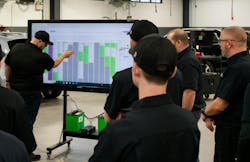In this article, we will review some key signs that your shop operates following lean practices. There are many lean principles which support a shop that operates in a lean environment, but these things signal those underlying tools have been considered. In the article, we have used a bold font to reinforce the 12 key lean principles most repairers try to embrace.
Process-Driven
If a shop is process-driven, it has a daily output target and tracks the number of hours or vehicles which move between departments each day in a level flow. This is due to level scheduling, considering optimal WIP and constant monitoring of the kanban production plan (Floor Plan in CCC), pulling work from the detail area forward through all departments to achieve this level flow. The more advanced operators would meet to see what setup reduction can be done upstream to the paint flow, reassembly, and detail area so vehicles consistently depart on time. The staff would know how to look at the current load and shift the staff to the appropriate department to get a consistent daily output every day of the week.
The process-driven shop has a technician advisory committee that has agreed upon interdepartmental quality standards and constantly updates the work standards to achieve these standards to assure quality through continuous improvement. Having a well-researched repair using OEM repair procedures and tools and equipment to their optimal performance reinforces a “right the first time” mentality. If you ask the technicians if they have a personal development or learning plan, they say yes, that the shop is consistently reinforcing lifetime learning.
If vehicles are consistently fixed correctly, then the focus has shifted to speed: Speed in process of repair, such as using a REVO light to dry filler and primer to minimize errors and enable faster work. The institution of a solid zero-day repair policy for bumpers or other one to three-panel repairs. This may include “direct to paint” and painting parts off the vehicle to enable these “bumper express” jobs to be processed in a few hours or at least less than a day. Painting parts upon vehicle arrival on both sides and then taking to repair planning to transfer the parts during disassembly should have reduced the number of supplements and minimized slowdowns during reassembly. The target is vehicles (with all the parts kitted and ready) are worked on at least 50% of the day or four hours or units per day repaired. Then you know the shop is pretty lean!
Visual Systems
Performing a waste walk, auditing shop processes or performing a value-stream map would NOT yield many instances where you observe wasted motion, vehicle or part transportation, defects, overproduction, excess production, see excess inventory, or other waste.
As you walk the shop, you would see “everything has a place, and is in its place,” when not in use. Some shops may even have an image of the stall in a 5S state and list the key things to be done at the end of each day.
You might see a total productive maintenance log to ensure the shop is clean, tools are put away, equipment is in working order, and things are generally where they belong. Equipment would have simple guides on use and maintenance nearby on cards or using on-line resources.
If you walked into the supply area, the kanban replenishment system would have clear labels with min and max for each item. They would have the clips and fastener area set up the same way with a quick way to bar code items to deplete inventory to automate building the order and replenishing the stock (as well as enabling billing for these items).
The shop would have lines on the floor designating vehicle stalls, labels signifying work areas, cones or signs organizing the parking lot, an easy-to-understand key management system and clear visual signage where tools belong when not in use.
Continuous Error Logging
So, the above visual indicators were the easier to spot signs of a lean operator, but the real gem is here…. Does the repair center value tracking errors, and either resolve them immediately, or do they agree to log the error and note their possible solution at the formal meeting?
When I was in Aaron Marshall’s shop and John Swiegart’s shop, these gems were not as visually obvious, as they were either on the wall or in a binder near a work area, but the information they contained was pure gold for someone who really cares about waste or error elimination.
Ask the technicians in the shop if they find value in these logs. If yes, they get it!
Formal Continuous Improvement Meetings
The true lean practitioner sees these meetings to mine the gold or gems in the waste and error logs and then to modify the processes to enable the minimization or elimination of these errors or waste. It may start with more detailed training or coaching on the current processes, or it could be a current state, future state discussion on how the processes can be tweaked to meet the quality standard or to perform the work better or faster.
The best operators track KPIs before and after the improvements have been made. The best example I can think of is a progressive and innovative MSO I worked with many years ago. The shop was asked to log the frequency of second supplements AFTER the disassembly. They found nearly 53% of all RO’s had a second supplement and 37% had a third. They then logged why these supplements were occurring, brainstormed how to prevent them, and continued to track supplements until they were significantly reduced. The KPI they improved most was repair cycle time, as the time was literally a day less because there was no waiting for the part or approval, the repair had a fully kitted parts cart, and the repair was able to continuously flow.
Importance of Celebration and Recognition
The shop owner MUST look for ways to recognize those tracking errors and those offering suggestions to improve. If the KPI improves, recognize them at company functions or their family at the annual holiday party. Moreover, I have always believed in a GENEROUS financial reward to thank them for their willingness to become an unpaid process engineer! Failure to share the wealth, makes folks question your sincerity to the mission of continuous improvement and a process-driven repair center.
This concludes the series on lean and process-driven repairers. Please comment or email me at [email protected] if you would like more detailed articles on any of these topics in the future.
About the Author
Steve Trapp
Steve Trapp is an internationally known consultant and speaker. His family operates a collision repair center in Wisconsin. He earned a degree in economics education and a minor in accounting from the University of Wisconsin.
After college, he worked for 3M in sales and marketing roles with the innovative 3M ARM$ training and software sales. He worked as a consultant for AutocheX doing financial consulting for a few years before joining AkzoNobel, where he started the industry’s first value-added program. While there, he started the industry’s first paint company-sponsored 20 groups and wrote numerous training programs with third-party experts on finance, marketing, selling, leadership, and other topics.
He later joined DuPont/Axalta, where he worked with Mike Anderson to manage their 20 groups and industry seminars. While at Axalta, he managed the North American Strategic Accounts SAM team and later the entire EMEA Strategic Accounts team. He followed that as senior consultant for LEAP, a global consulting firm that has presented in 10 countries and now again works for a major paint company.

